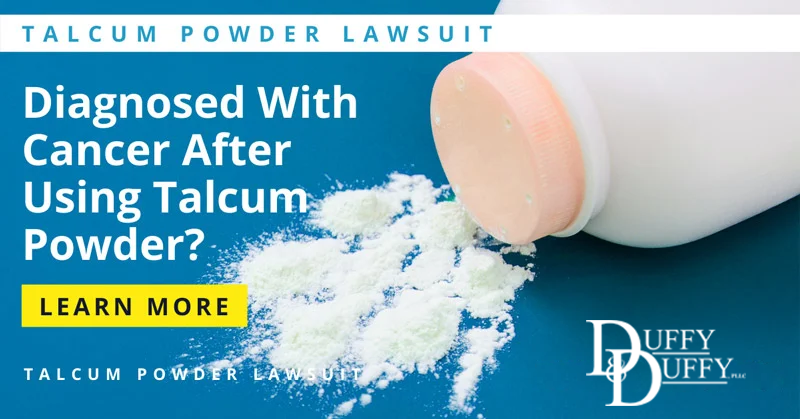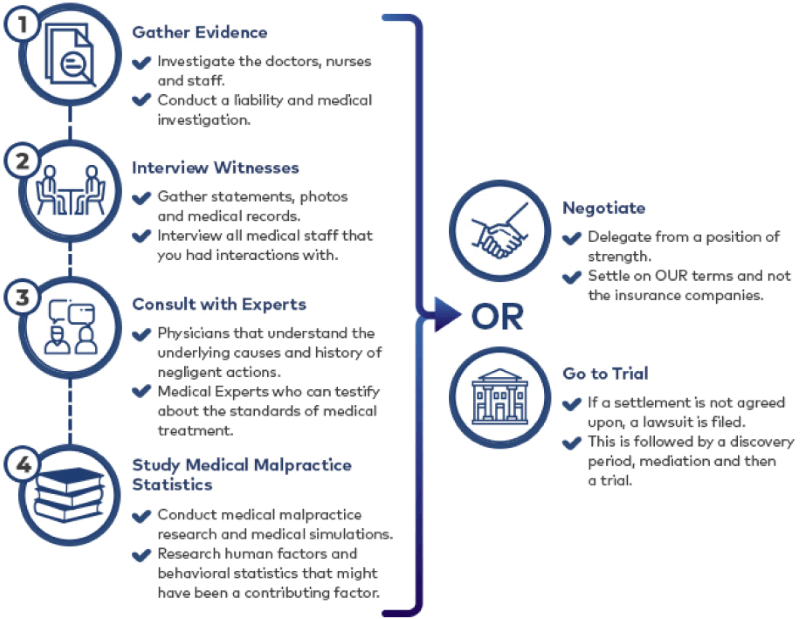Talcum Powder
Duffy & Duffy Law is reviewing cases on behalf of women who developed ovarian cancer or mesothelioma after using talc powder or other talc products.
Request a FREE Case Review
You may be entitled to compensation.
About the Talcum Powder Lawsuit
Since 1971, more than 20 studies have linked talcum (talc) powder to ovarian cancer, and, in 2003, an analysis of 16 of these studies found that ** women using talcum powder were 33 percent more likely to develop ovarian cancer.** It has been alleged that Johnson & Johnson, the maker of popular talc-based products, knew about the risk of ovarian cancer since at least 1982, but failed to warn women using these products.
In addition, recently unearthed information reported by The New York Times showed that Johnson & Johnson knew of the possible link of asbestos to their talc products. According to the article, the company spent decades trying to keep this negative information from reaching the public

Does Talcum Powder Cause Cancer?
For decades, researchers have been studying the potential link between ovarian cancer and talcum powder. It is believed that talc powder, when used near the genitals, can travel to the ovaries and become embedded in ovarian tissue. While talc is a natural mineral, it is very difficult for the body to remove the particles, and, as a result, inflammation may occur and cancerous tumors may form.
The first study to suggest that talc may cause ovarian cancer was published in 1971 in the medical journal The Lancet. In the study, researchers discovered that a majority of ovarian tumors had talc particles “deeply embedded” in them. Then, in 1982, researchers found that women using talcum powder during ovulation were at a 92 percent increased risk of developing ovarian cancer. During the next three decades, an additional 21 studies were performed on talc powder, and almost all of these studies found that women using these products near their genitals were at an increased risk for developing ovarian cancer.
To date, both the National Cancer Institute and the American Cancer Society consider talc use near the genitals as a “risk factor” for ovarian cancer. Despite this possible link, Johnson & Johnson and other talc powder manufacturers have not placed warnings about this risk on their products.
Frequently asked questions
Talc is a soft, naturally occurring mineral made of oxygen, silicon, and magnesium. After talc is mined and processed, the resulting fine powder is used in a variety of cosmetic products.
Talc appears in a wide range of products, including talcum powder (baby powder), feminine hygiene products, makeup, lotions, and deodorant. As talcum powder is known for its odor-and-moisture-absorbing properties, some women use it in their genital area. Genital exposure to the mineral can also occur during condom, menstrual pad, or diaphragm use.
In nature, talc deposits are often found near dangerous accumulations of the carcinogenic mineral asbestos. Asbestos has been linked to many types of cancer, including ovarian cancer and mesothelioma, a rare disease of the lungs. Even trace amounts of asbestos have the potential to cause cancer, and diagnoses are often made decades after a talc-containing product was used.
Although the federal government required talc-based wares to be asbestos-free starting in the 1970s, scientists have noted that it is difficult to comply. In addition, there is evidence that companies continued to sell talc products that tested positive for asbestos long after regulations went into effect. A recent Reuters report showed that Johnson & Johnson’s baby powder contained asbestos from 1971 through the early 2000s, exposing consumers to serious risks for decades.
The International Journal of Gynecological Cancer states that women who use talcum powder on their genital area have a 30% to 60% increased risk of cancer. Researchers believe that talc causes the disease by provoking chronic inflammation of the fallopian tubes, uterus, and ovaries, and potentially suppressing cancer-fighting antibodies.
Talcum powder also has been connected to mesothelioma, a rare lung cancer. When the small airborne particles enter the lungs, they can cause irritation, chronic inflammation, and the eventual formation of cancerous tumors.
Thousands of people who have been diagnosed with ovarian cancer and mesothelioma have filed lawsuits against companies that use talc in their products. Johnson & Johnson has been at the center of many recent lawsuits, with victims claiming that they developed cancer after using the company’s talc-based items consistently for years.
Another key aspect of the lawsuits involves prosecuting attorneys’ claims that manufacturers like Johnson & Johnson knew for over 40 years that their products contained asbestos. According to internal J&J documents, the company concealed this information from the public and refused to put safety warnings on its items or remove them from sales shelves.
As of March 2019, more than 13,000 lawsuits were pending against Johnson & Johnson. Lawsuits are also pending against other talc product manufacturers.
There have been several settlements and verdicts against Johnson & Johnson, Colgate-Palmolive, and other manufacturers for cases involving ovarian cancer and mesothelioma. Settlements are on the rise in 2019.
The largest verdict against J&J was in July 2018, when a St. Louis jury awarded 22 ovarian cancer victims $4.6 billion after concluding that their use of the company’s baby powder caused their ovarian cancer. In May 2018, $25 million was awarded to Joanne Anderson by a jury concluding that her mesothelioma was caused by her use of talcum powder. In June 2019, Johnson & Johnson and Colgate-Palmolive were ordered to pay $10 million to Patricia Schmitz, who was diagnosed with terminal mesothelioma after using their talc products.
These are just a few recent examples of verdicts against companies. From 2016 to today, manufacturers of talc products have paid hundreds of millions of dollars to victims.
Despite many losing verdicts and settlements, companies continue to claim that their products are safe and do not contain asbestos or cause cancer.
If you have been diagnosed with mesothelioma or ovarian cancer after using talc-based products, you may be eligible to file an individual lawsuit, especially if you have a consistent history of using such wares over a significant time period.
The more frequently you used the product and the longer the duration, the more likely it is that your cancer could have been caused by one containing talc. Because statutes of limitation for filing a lawsuit vary by state, it is in your best interest to speak with a lawyer as soon as possible after your diagnosis.
What you can recover depends on the type of lawsuit you file. For example, there is a class action lawsuit filed against Johnson & Johnson where many consumers are suing for damages related to the cost of the product. However, it is important to understand that class actions do not cover individual health-related costs.
If, on the other hand, you file an individual lawsuit, you may be able to receive compensation for medical bills, lost wages, pain and suffering, and other expenses. Each case is different, and depending on the cost of your medical bills, the symptoms you experienced, and how much work you missed, the final settlement amount will vary.
A good lawyer will ensure that your best interests are taken into account. They will make sure you meet important deadlines, give you a clear understanding of your legal rights, and supply trusted expert witnesses to bolster your case.
Contact Us
Contact us today at 516-394-4200 or info@duffyduffylaw.com
Our Experienced Medical Malpractice Attorneys guide you through every step.
When you contact our NY firm, you can rest easy knowing that we provide both sound legal advice as well as a compassionate attitude to walk alongside you. Although your experience was both physically and emotionally painful, our lawyers will give you peace of mind. It’s imperative that you seek out a local law firm that is after your best interests. We have earned a reputation as aggressive litigators and we will take the time to talk through your case, listen to your concerns, and guide you through the legal process. When you contact our firm, you can rest easy knowing that we provide both sound legal advice as well as a compassionate attitude to walk alongside you.
How We Succeed Together


Schedule a Consultation
Please complete the form below and a member of our team will get in touch with you as soon as possible.